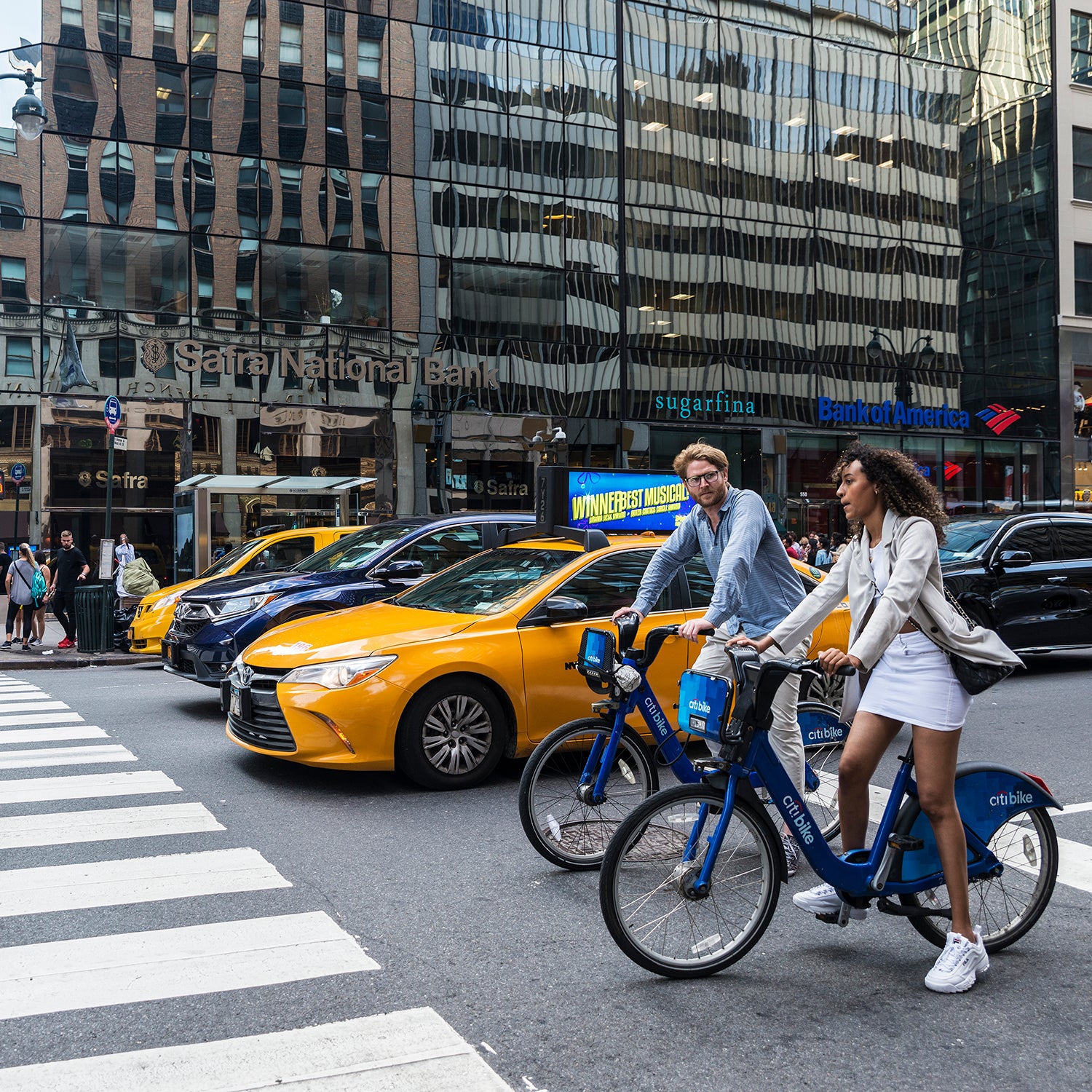To capture the beauty, diversity, and conflict inherent in the African wildlife ecosystem, the BBC built an artificial body of water in Tanzania and fitted it with hidden cameras. The result was “Life at the Waterhole,” a three-part series that PBS describes :
The series reveals dramatic interactions and unlikely rivalries, as well as some unexpected moments of humor. As elephants, warthogs, giraffes, monkeys and big cats jostle for position, scientists gain a greater understanding of the important role of water in Africa as its wildlife faces the growing impact of climate change.
While I haven’t visited an African water hole, I am a resolute city dweller and bicyclist—and inasmuch as bicyclists and city dwellers are prone to facile pronouncements, I feel comfortable saying that our equivalent is the intersection. Nationally, occur at intersections. Here, “dramatic interactions and unlikely rivalries” also abound—only instead of elephants and warthogs and giraffes, it’s cars and pedestrians and bikes. And while the animals may be competing for water, the resource that compels all of these road users is the city itself. Commerce, culture, education, recreation: these are the city’s “water,” and the need to partake in them is what dictates everyone’s movements. These movements in turn lead to interactions that can be anything from delightfully serendipitous to deadly.
Here in New York City, the Intersection Capital of the United States (with , nearly ), there’s no better way to observe this ecosystem than by coming to a complete stop at a red light on your bicycle and taking in your surroundings. Yes, there’s a common conception that bicyclists don’t stop for red lights, and to be fair, this is not totally unfounded—in fact, running red lights is arguably necessary in certain situations. But watch a city intersection for a while and you’ll find that nobody stops for them, at least not really, and certainly not consistently. Pedestrians slip through gaps in traffic. Bicyclists practice the “” (not yet legal in New York), even though most of them probably have no idea there’s a name for it. And drivers afford themselves a five-second grace period after the light turns red, during which there’s a tacit understanding that they’re going to gun it and speed right through if there’s an opening in traffic.
This downward pressure from the automotive apex predator results in curious behavior from the other species, who are in a constant state of fleeing for their lives.
At an intersection, anything can happen at any time, but in the five seconds after the light turns red, it crackles with the possibility of sudden death. Look around you and you’ll see it in the wary eyes of your fellow travelers. Walkers hesitate before putting a foot forward; bicyclists scan the streetscape before pushing off. They’re like zebras on high alert for predators, sniffing for danger in the wind before tentatively lowering their heads to take a sip. Whether it’s the water hole or the intersection, an attack is inevitable. Sometimes it’s the driver of a Dunkin’ Donuts rig, blasting the horn before charging through the red light; other times it’s someone behind the wheel of a car who’s whipping around the corner like a frisky cat from the other room. With each cycle of the traffic signal, it seems like there’s always at least one person who manages to escape death by the width of a goose bump… .
This downward pressure from the automotive apex predator results in curious behavior from the other species, who are in a constant state of fleeing for their lives. More vulnerable and yet more nimble than people in motor vehicles, bicyclists forced to wait for oncoming traffic will generally try to get a jump on the drivers bearing down on them by track standing, riding around in circles to avoid putting a foot down, or reverse queueing in front of each other until they jut out into the intersection (a bizarre process called ). Or else they’ll simply run the light altogether—some in a tentative and cautious fashion, others rolling casually through in a state of Mr. Magoo–like oblivion, and still others simply going for it like squirrels.
These bicyclists can unsettle the pedestrians—who, while watching for drivers, must also contend with the addled cyclists who are variously occupying their crosswalk—or even While considerably less of a threat to pedestrians than drivers, bicyclists are in a way more vexing; they appear suddenly while you’re scanning for more obvious threats, and thus have much more of a capacity to startle. In turn, some bicyclists complain of “oblivious” pedestrians stepping out into their path or sauntering across bike lanes. But who can blame pedestrians for doing so? A bicyclist who surprises you is scary, but one in plain view is so benign as to be easily ignored, especially on a street full of cement trucks.
A more recent addition to this ever-changing ecosystem is the preponderance of electric contraptions—e-bikes, e-skateboards, e-scooters, Onewheels—some of which are capable of rather high speeds. Drivers, bicyclists, and pedestrians may quibble over who’s the worst, but for now many seem united in their contempt for the new wave of e-assisted conveyances, in the same way . Based on familiar vehicles like bicycles and skateboards, these e-machines move at an altogether different pace—faster than bikes and yet slower than cars—and to someone who’s been plying the streets of the city for a long time, they can be quite disconcerting, like those creepy .
Despite all the changes the city has made to the streetscape, the intersection remains a place of peril.
To its credit, the city has been working to tame the intersection. In 2010, the Department of Transportation that 74 percent of crashes resulting in death or serious injury to pedestrians happened at intersections. Around half of those occurred at intersections with signals, and over half of the walkers had the signal in their favor. it has identified over 200 priority intersections for safety treatments and redesign, and implemented pilot programs, such as signals giving pedestrians and cyclists a head start on motorists (known as a ). This allows the smaller animals to drink first while the red traffic light holds predators at bay.
Still, the world moves much more quickly than city agencies do. The rapid shift to online retail means the streets are choked with trucks, some of which disgorge packages while parked in the bike lane. Meanwhile, —not just the usual commuters and recreational riders but also commercial cyclists on e-bikes working for food-delivery apps. When the city installed it seemed impossibly exotic, like something imported from the bike utopias of Amsterdam and Copenhagen. Now, in the age of , the very idea of a bike lane is almost quaint, and as people on every conceivable form of wheeled locomotion speed by you, it can feel as though the improvisational and instinct-driven nature of getting around New York will always remain just ahead of the city’s efforts to bring order to it.
Despite all the changes the city has made to the streetscape, the intersection remains a place of peril. In July of 2021, a bicyclist riding in the new protected bike lane alongside Central Park in Manhattan by the driver of a U.S. Postal Service truck, who appears to have struck the rider while making a right turn onto the 86th Street transverse, a motor-vehicle thoroughfare that carries heavy traffic across the most used park in the United States. The city installed the bike lane on Central Park West after an Australian tourist on a rental bike . Four years and a redesign later, this confluence of commerce and recreation and culture and education and residential life is still treacherous. Vehicles of every size and description, piloted by people often at cross purposes, travel along a roadway that serves as a line of demarcation between the bustling city and the respite of the park.
New York City is either a vast desert or a giant oasis, depending on who you ask. There’s a water hole at the end of every block, and at any one of them you might meet your fate.


